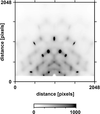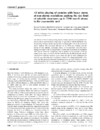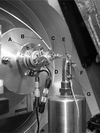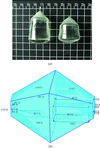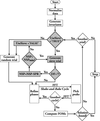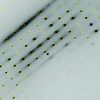issue contents
June 2008 issue

Cover illustration: Two-dimensional grazing-incidence X-ray scattering pattern for a PS-b-PI thin film deposited on a silicon substrate. Courtesy of Sangwoo Jin et al. [J. Appl. Cryst. (2007), 40, 950-958].
lead articles
The algorithms underlying small-molecule refinement programs are described in nonmathematical terms, together with practical examples and advice on their use.
research papers
Dual polarization interferometry supports recent hypotheses that the critical nuclei of protein crystals arise from a large stable disordered protein aggregate. It also promises early detection for the onset of protein crystallization in crystallization trials.
Errors on anisotropic displacement parameters are propagated to bond-length and angle corrections from TLS analysis via errors on the TLS parameters.
Simulations using the Debye formula have been performed to explain the X-ray powder diffraction patterns of stress-free and homogeneous samples of nitrogen-expanded austenite, synthesized by low-temperature gaseous nitriding of stainless steel.
The atomic positions of Mn impurities in GaMnAs layers were determined by means of X-ray diffuse scattering.
New algorithms have been devised to attempt ab initio protein crystal structure solution for data resolutions of up to 2 Å.
Correct incorporation of finite size effects on the pair distribution function of nanoparticles is important for quantifying the structural effects of finite particle size in nanomaterials.
This paper describes the modelling of the azimuthal scattering profiles of high-performance fibres in an on-axis microdiffraction geometry.
Time-resolved diffraction studies into the pressure acid leaching of nickel laterite ores have been conducted using laboratory X-ray and synchrotron radiation sources. The results are compared with respect to reaction mechanism and data analysis techniques.
Download citation


Download citation


A series of possible growth faces (hkl) were determined from the crystal lattice and symmetry of Yb3+-doped NaY(WO4)2 according to the Bravais–Friedel Donnay–Harker theory, and the relationship among crystal structure, growth habits and crystal morphology is discussed. In addition, the thermal properties of the crystal, including the specific heat, thermal expansion, thermal diffusion and thermal conductivity, are investigated.
Correcting resolution bias in electron density maps provides additional power to direct methods when applied to powder data.
Diffraction images from an incommensurately modulated crystal containing the profilin:actin complex were indexed using software developed for small-molecule modulated and twinned crystals.
Computer simulations have been carried out to test the recently proposed model for the nanodomain structure of relaxor ferroelectrics such as lead zinc niobate (PZN). The present results confirm that  and
and  as well as the previously proposed
as well as the previously proposed  types of Pb displacement are viable possibilities, but the number of domain boundaries required to produce sufficiently strong diffuse rods of scattering means that individual domains cannot be described as three-dimensional and must still be considered to be relatively thin plates.
types of Pb displacement are viable possibilities, but the number of domain boundaries required to produce sufficiently strong diffuse rods of scattering means that individual domains cannot be described as three-dimensional and must still be considered to be relatively thin plates.
A new anisotropic size-broadening model, based on a spherical-harmonics representation and convenient for implementation into Rietveld programs, is described. The model is interpreted in terms of physical models by using ellipsoidal and cylindrical crystallites with lognormal size distributions.
The effect of moisture content on native soy glycinin is determined using small-angle scattering techniques. Scattering data suggest that the protein expands as the moisture content increases and a hexagonal crystal structure is demonstrated. Scattering data are complemented by electron microscopy, indicating a corresponding expansion of the microstructure with moisture content.
short communications
Download citation


Download citation


The structure of the title compound was optimized by energy minimization in the solid state at the DFT level of theory using the lattice parameters obtained from high-temperature synchrotron X-ray powder diffraction data.
The pressure dependences of the lattice parameters of two spin transition compounds, Fe(PM–AzA)2(NCS)2 and Fe(PM–BiA)2(NCS)2 [PM is N-2′-pyridylmethylene, AzA is 4-(phenylazo)aniline and BiA is 4-aminobiphenyl], have been derived from neutron powder diffraction measurements at ambient temperature.
computer programs
The CHAINSAW program, which mutates template structures for use in molecular replacement, is described.
A new version of SnB implements the triplet sieve method for phasing centrosymmetric structures.
A program for visual demonstration of reciprocal-space building for crystals and the principles of X-ray (electron, neutron) diffraction on bulk and two-layered crystals is presented.
A cross-platform program, VESTA, has been developed for three-dimensional visualization of both structural models and volumetric data such as electron and nuclear densities, Patterson functions, and wavefunctions.
letters to the editor
Free 

It is suggested that it would be useful if raw X-ray diffraction images could be included in data depositions with the Protein Data Bank.


 journal menu
journal menu












